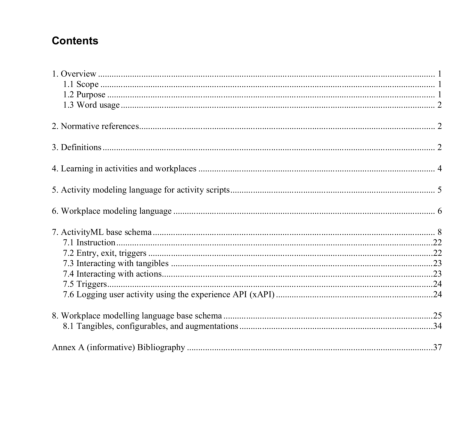IEEE 1589-2020 pdf download.IEEE Standard for Augmented Reality Learning Experience Model
This standard defines two description languages for expressing augmented reality (AR) learning experiences. This document shows how to represent activities conducive to developing or upgrading knowledge, skills, abilities, and other characteristics in a standardized interchange format. The interchange format links the representation of learming activities with their environment and context in the actual (or simulated) workplace, classoom, or other environment in which an AR-enhanced training system may execute them. The specification aims to lower entry barriers for authoring of learming experiences that involve interaction with the real world, sensors, computer vision, and web applications.
1.2 Purpose
This standard for augmented reality learning experience models (ARLEMs) provides an overarching integrated conceptual model and the corresponding data model specifications for representing activities, learmning context, and environment (aka “workplace”), while linking with other data model components needed for AR-enhanced learning activities.
The standard distinguishes slow-changing data for environment description from fast-changing data for step-by-step guidance. It defines the required data models and modeling languages and their bindings to Extensible Markup Language (XML; see XML 1.0) and JavaScript Object Notation (JSON; see ECMA-404).’
The purpose of this standard is to support the discovery, retrieval, transfer, and exccution of AR-enabled learning content, thereby facilitating the creation of repositories and online marketplaces.
Finally, the standard supports reuse and repurposing of existing (leamning) content in“*mixed” experiences that combine real-world guidance with traditional media such as instructional video material or existing web applications and widgets.
1.3 Word usage
The word shall indicates mandatory requirements strictly to be followed in order to conform to the standard and from which no deviation is permited (shall equals is required to).
The word should indicatces that among several pssibilii one is reoomended s paricularly suitable, without mentioning or excluding others; or that a certain course of action is preferred but not nessarily required (should equals is rcommended thal), The word may is used to indicate a course of action prmissible within the limits of the standard (may equals is pemited to). The word can is used for statements of pssibility and capabiliy whcther material, plysical, or causal (can equals is able to).
2. Normative references
The fllowing refcrenced documents are indispensable for the ppliaion of this document lic, they must be understood and used, so each referenced document is cited in text and its relationship to this document is explained). For dated references, only the edition cited applies.
For undated references, the latest edition of the referenced document (including any amendments or corrigenda) applies. ECMA-404, The JSON Exchange Network.
IS0 639-1, Codes for the representation of nanes of languages- Part 1: Alpha-2 code.
IsO 7010, Graphical symbolb- Safety colours and safety signs- Registered satcty signs. OASIS, Mesage Queuing Telemery Transport (MQTT), 2014.* Rustici Software, Experience API (xAPI).” Rustici Software, xAPI Client Libraries.
W3C Recommendation, Extensible Markup Language (XML) 1.0, 5h ed, 2008.8 W3C Rcommendaion, Packaged Web Apps (Widget)- Packaging and XML. Configuration, 2nd ed, 2012. 3. Definitions For the purposes of this document, the ollowing terms and definitions apply.
The IEEE Standands Dictionary Online should be consulted for terms not defined in this clause.”
activity: The execution of a planned workflow following a specific process, leading typically from beginning to end, regardless of whether the anticipated learning outcome is achieved.
augmentation: The digital representation of effector outputs that serve to stimulate the sensory experience of the user, including output to visual, audio, haptic, and other modalities.
augmentation primitive: The types of annotations available are defined in the augmented reality (AR) training system. They include, but are not limited to, audio, video, images, animations, labels, and vibrotactile patterns.IEEE 1589 pdf download.IEEE 1589-2020 pdf download
IEEE 1589-2020 pdf download

Leave a Reply